Resonating across an Anglican-Xhosa mission soundscape: a case study of instruments, bells, and processions
IF 1.8
3区 社会学
Q2 CULTURAL STUDIES
引用次数: 0
Abstract
ABSTRACT What might the study of soundscapes bring to postcolonial understandings of past musical practices? In this article, I explore this question with reference to archives documenting that nineteenth-century mission activities are full of auditory information. Accounts of hymn singing, printed artefacts, and methods of musical pedagogy are a few examples of the evidence we find in the mission archive that indicates the part that music and sound played in the life of mission stations around the world. This evidence raises critical questions about the ways in which the soundscape featured in the encounter between missionaries and Indigenous peoples. For instance, how did Indigenous people interpret and refashion musical forms introduced by missionaries? And how did Indigenous musicality and understandings of sounds impact the musical culture of missions? I address these and other questions by examining three key elements of the soundscape—instruments, bells, and processions—found on the Anglican-Xhosa missions, established in the Eastern Cape, South Africa in 1855, in an attempt to articulate how music and sound mediated religious experience, and how this experience was contested by missionaries and Indigenous peoples.在英国圣公会-科萨教会的音景中产生共鸣:乐器、钟声和游行的案例研究
对音景的研究可能会给后殖民时代对过去音乐实践的理解带来什么?在这篇文章中,我通过参考档案来探讨这个问题,这些档案记录了19世纪的传教活动充满了听觉信息。我们在宣教档案中发现的一些证据,包括唱赞美诗、印刷工艺品和音乐教学方法,这些证据表明音乐和声音在世界各地宣教站的生活中所起的作用。这一证据提出了一个关键的问题,即传教士和土著人民相遇时,音景的特点是什么。例如,原住民如何诠释和改造传教士引入的音乐形式?土著的音乐性和对声音的理解是如何影响传教团的音乐文化的?我通过检查声景的三个关键元素——乐器、钟声和游行——来解决这些问题和其他问题,这些元素是在1855年在南非东开普省建立的英国圣公会-科萨教会中发现的,试图阐明音乐和声音是如何介导宗教体验的,以及这种体验是如何受到传教士和土著人民的质疑的。
本文章由计算机程序翻译,如有差异,请以英文原文为准。
求助全文
约1分钟内获得全文
求助全文

 求助内容:
求助内容: 应助结果提醒方式:
应助结果提醒方式:


